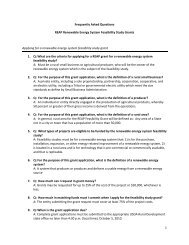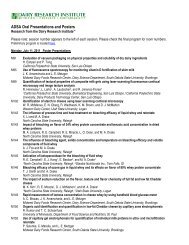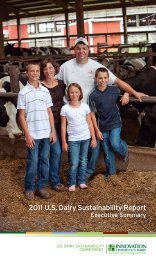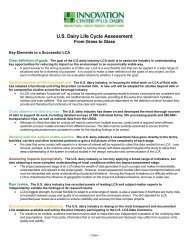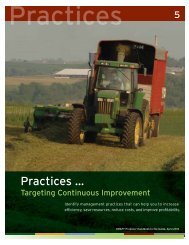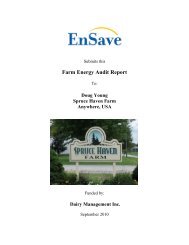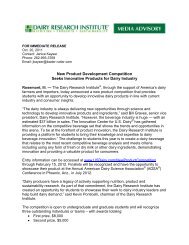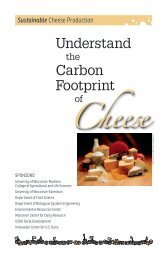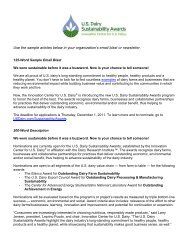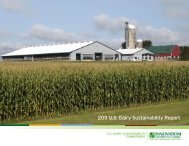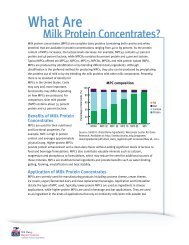Processor Handbook - Innovation Center for US Dairy
Processor Handbook - Innovation Center for US Dairy
Processor Handbook - Innovation Center for US Dairy
Create successful ePaper yourself
Turn your PDF publications into a flip-book with our unique Google optimized e-Paper software.
1<br />
QWho defined the vision<br />
Through the <strong>Innovation</strong> <strong>Center</strong> producers, cooperatives,<br />
processors, retailers and businesses have worked together —<br />
pre-competitively — to find new ways to continue supplying<br />
nutritious products that are responsibly produced and<br />
economically viable.<br />
This common commitment is collectively addressing the<br />
challenges and capitalizing on opportunities that will contribute<br />
to a resilient and sustainable 21st century food system.<br />
The U.S. dairy industry’s dedication to production efficiency,<br />
commitment to creating a sustainable future and its strong<br />
belief in collaboration are the underpinnings of the Guide’s vision.<br />
The U.S. dairy industry has achieved many accomplishments<br />
over the years, but also recognizes there is room to do even<br />
more across the dairy value chain.<br />
Our definition of sustainability is: Providing<br />
consumers with the nutritious dairy products they want,<br />
in a way that makes the industry, people and the earth<br />
economically, environmentally and socially better — now<br />
and <strong>for</strong> future generations.<br />
Goal to secure future<br />
The Guide contains a set of Guiding Principles, which<br />
expresses U.S. dairy’s values; topics that follow a triple<br />
bottom line approach to sustainability with environmental,<br />
social and economic categories and indicators and metrics<br />
<strong>for</strong> tracking and demonstrating results and outcomes.<br />
QHow was the Guide developed<br />
As with dairy nutrition, the Guide uses sound science as<br />
its foundation <strong>for</strong> building credibility, setting the record<br />
straight on stewardship and identifying opportunities to<br />
maximize per<strong>for</strong>mance while conserving natural resources.<br />
Founded in science<br />
The Guide is based on Life Cycle Assessment (LCA)<br />
research studies conducted on behalf of the <strong>Innovation</strong><br />
<strong>Center</strong> from 2008 to 2012. These studies surveyed 536<br />
dairy operations of varying size and structure in different<br />
regions of the country to understand the environmental<br />
impact created by dairies. The LCA, which follows worldrecognized<br />
international standards, including ISO,<br />
established an accurate baseline of U.S. dairy’s GHG and<br />
water footprint from grass-to-glass. It also identified<br />
opportunities <strong>for</strong> improvement from feed and milk<br />
production through transport, processing, packaging and<br />
distribution all the way to the consumer.<br />
The results of this research have helped the dairy industry<br />
define the most important topics and indicators to measure<br />
what matters <strong>for</strong> processors and manufacturers.<br />
Developed with partners<br />
Industry-led stakeholder groups, a comprehensive<br />
organizational structure and a transparent process<br />
overseen by the Sustainability Council, were created to<br />
collaboratively develop the Guide. The structure includes<br />
checks and balances among several multi-stakeholder<br />
groups, including the Council and the <strong>Innovation</strong> <strong>Center</strong>’s<br />
Board of Directors. It also included a 30-day industry<br />
consultation period. In the summer of 2013 a 60-day<br />
consultation period will give stakeholders and others the<br />
opportunity to provide additional feedback.<br />
continued on page 8<br />
7





